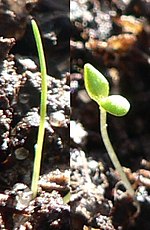
| Home | Sources Directory | News Releases | Calendar | Articles | | Contact | |
Cotyledon



A cotyledon (pronounced /ˌkÉ�tÉ�lˈiːdÉ�n/; "seed leaf" from Greek: î�î¿�„υî»î�î��Žî� kotylä�dÅ�n, gen.: î�î¿�„υî»î�î�όî�î¿ς kotylä�donos, from î�î¿�„ύî»î� kotýlä� "cup, bowl"), is a significant part of the embryo within the seed of a plant. Upon germination, the cotyledon may become the embryonic first leaves of a seedling. The number of cotyledons present is one characteristic used by botanists to classify the flowering plants (angiosperms). Species with one cotyledon are called monocotyledonous (or, "monocots") and placed in the class Liliopsida. Plants with two embryonic leaves are termed dicotyledonous ("dicots") and placed in the class Magnoliopsida.
In the case of dicot seedlings whose cotyledons are photosynthetic, the cotyledons are functionally similar to leaves. However, true leaves and cotyledons are developmentally distinct. Cotyledons are formed during embryogenesis, along with the root and shoot meristems, and are therefore present in the seed prior to germination. True leaves, however, are formed post-embryonically (i.e. after germination) from the shoot apical meristem, which is responsible for generating subsequent aerial portions of the plant.
The cotyledon of grasses and many other monocotyledons is a highly modified leaf composed of a scutellum and a coleoptile. The scutellum is a tissue within the seed that is specialized to absorb stored food from the adjacent endosperm. The coleoptile is a protective cap that covers the plumule (precursor to the stem and leaves of the plant).
| Features | Monocotyledon | Dicotyledon |
|---|---|---|
| Leaf structure | Parallel veins | Network veins |
| Roots | Fibrous roots | Tap roots |
| Stem | Soft | Hard |
| No. of cotyledons | 1 | 2 |
| Number of petals | Divisible by 3 | Divisible by 4 or 5 |
Gymnosperm seedlings also have cotyledons, and these are often variable in number (multicotyledonous), with from 2 to 24 cotyledons forming a whorl at the top of the hypocotyl (the embryonic stem) surrounding the plumule. Within each species, there is often still some variation in cotyledon numbers, e.g. Monterey Pine (Pinus radiata) seedlings have 5'9, and Jeffrey Pine (Pinus jeffreyi) 7'13 (Mirov 1967), but other species are more fixed, with e.g. Mediterranean Cypress always having just two cotyledons. The highest number reported is for Big-cone Pinyon (Pinus maximartinezii), with 24 (Farjon & Styles 1997).

The cotyledons may be ephemeral, lasting only days after emergence, or persistent, enduring a year or more on the plant. The cotyledons contain (or in the case of gymnosperms and monocotyledons, have access to) the stored food reserves of the seed. As these reserves are used up, the cotyledons may turn green and begin photosynthesis, or may wither as the first true leaves take over food production for the seedling.
[edit] Epigeal versus hypogeal development
Cotyledons may be either epigeal, expanding on the germination of the seed, throwing off the seed shell, rising above the ground, and perhaps becoming photosynthetic; or hypogeal, not expanding, remaining below ground and not becoming photosynthetic. The latter is typically the case where the cotyledons act as a storage organ, as in many nuts and acorns.
Hypogeal plants have (on average) significantly larger seeds than epigeal ones. They also are capable of surviving if the seedling is clipped off, as meristem buds remain underground (with epigeal plants, the meristem is clipped off if the seedling is grazed). The tradeoff is whether the plant should produce a large number of small seeds, or a smaller number of seeds which are more likely to survive.[1][2]
Related plants show a mixture of hypogeal and epigeal development, even within the same plant family. Groups which contain both hypogeal and epigeal species include, for example, the Araucariaceae family of Southern Hemisphere conifers,[3] the Fabaceae (pea family),[1] and the genus Lilium (see Lily seed germination types).
[edit] History
The term cotyledon was coined by Marcello Malpighi. John Ray was the first botanist to recognise that some plants have two and others only one, and eventually the first to recognise the immense importance of this fact to systematics.[4]
[edit] References
- ^ a b Charles R. Tischler, Justin D. Derner, H. Wayne Polley, and Hyrum B. Johnson, Response of Seedlings of Two Hypogeal Brush Species to CO2 Enrichment, Fort Collins, CO: U.S. Department of Agriculture, Forest Service, Rocky Mountain Research Station, pp. 104'106, http://www.treesearch.fs.fed.us/pubs/28366
- ^ Baraloto, C.; Forget, P.-M. (2007), "Seed size, seedling morphology, and response to deep shade and damage in neotropical rain forest trees", American Journal of Botany 94: 901, doi:10.3732/ajb.94.6.901
- ^ Hiroaki Setoguchi, Takeshi Asakawa Osawa, Jean-Christophe Pintaud, Tanguy Jaffré and Jean-Marie Veillon (1998), "Phyloghuhenetic relationships within Araucariaceae based on rbcL gene sequences", American Journal of Botany 85 (11): 1507'1516, doi:10.2307/2446478, http://www.amjbot.org/cgi/content/full/85/11/1507
- ^ Vines, Sydney Howard (1913), "Robert Morison 1620'1683 and John Ray 1627'1705", in Oliver, Francis Wall, Makers of British botany, Cambridge University Press, pp. 8'43
- Tiscali.reference - Cotyledon
- Mirov, N. T. (1967). The Genus Pinus. Ronald Press Company, New York.
- Farjon, A. & Styles, B. T. (1997). Pinus (Pinaceae). Flora Neotropica Monograph 75: 221-224.
|
SOURCES.COM is an online portal and directory for journalists, news media, researchers and anyone seeking experts, spokespersons, and reliable information resources. Use SOURCES.COM to find experts, media contacts, news releases, background information, scientists, officials, speakers, newsmakers, spokespeople, talk show guests, story ideas, research studies, databases, universities, associations and NGOs, businesses, government spokespeople. Indexing and search applications by Ulli Diemer and Chris DeFreitas.
For information about being included in SOURCES as a expert or spokesperson see the FAQ . For partnerships, content and applications, and domain name opportunities contact us.